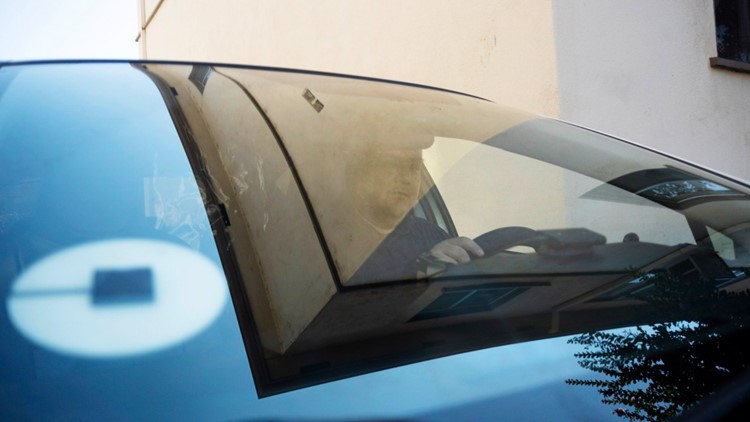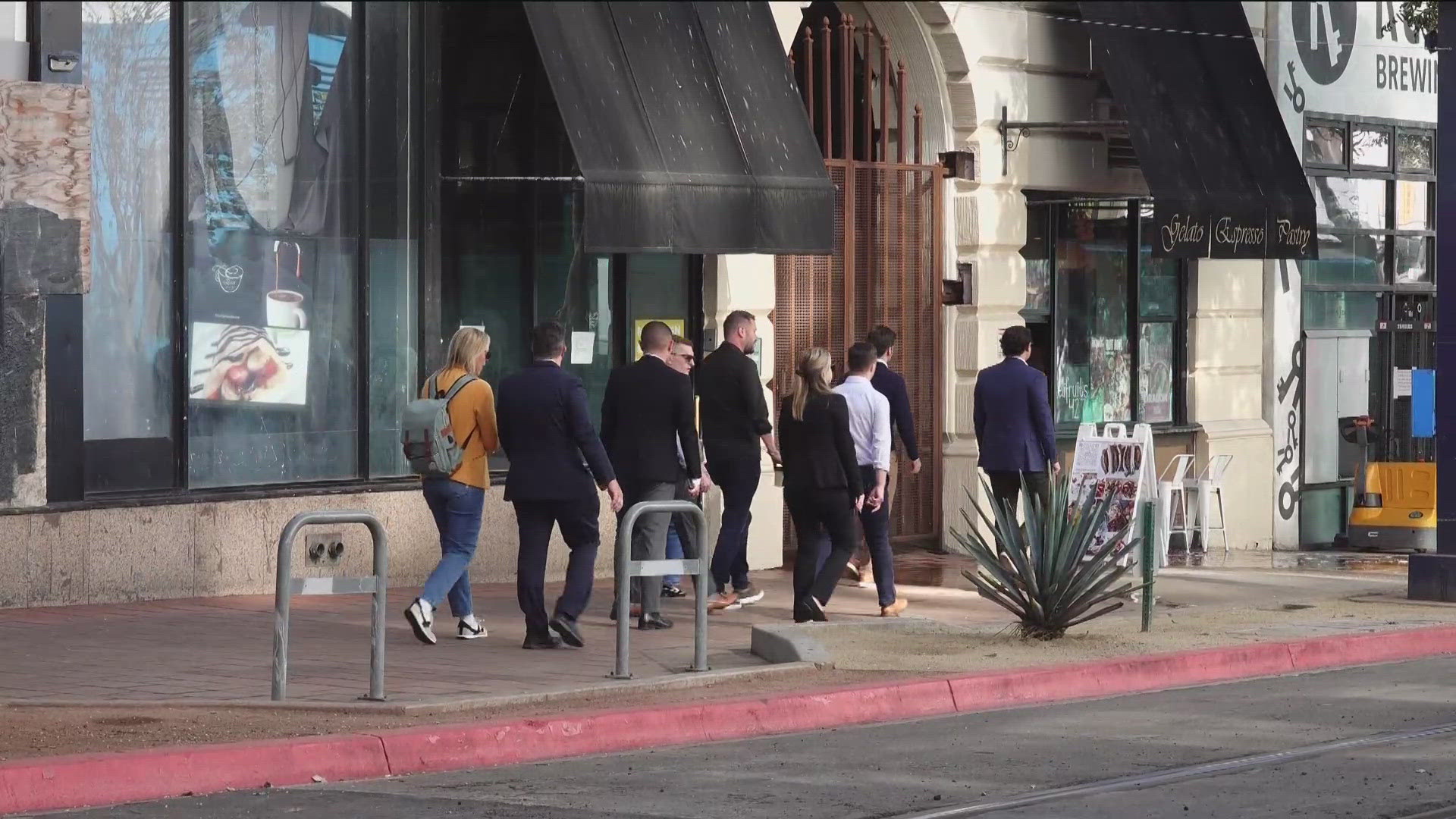CALIFORNIA, USA — How much will your Uber driver get paid if gig companies convince California voters to approve ballot measure Proposition 22? It could be anywhere from $5.64 to $27.58 per hour, depending who you ask.
As early voting begins this week, the most expensive state ballot measure in modern history has widened the fault lines in the battle over the future of work. Some app drivers among the many Californians scrambling for income during the pandemic say they’ll vote yes to keep making money quickly, despite lingering questions about how much they may earn. Others who have spent years dialing in the best-paying routes say they’ll vote no on Prop. 22, and that what they really need is a stable paycheck.
“It’s kind of like going to Vegas,” said Ben Valdez, a five-year Lyft and Uber driver in L.A. who opposes Prop. 22. “Sometimes you do really well, and sometimes you do horrible.” For Valdez, who drives 20-25 hours a week after his day job at a community college, horrible has meant $3 an hour. Hitting it big can be $400 in a 12-hour day, though that, too, can be eaten up quickly by costly car repairs.
With Prop. 22, which is backed by nearly $185 million from Uber, Lyft, DoorDash, Instacart and Uber-owner Postmates, gig companies aim to exempt themselves from the state’s new AB 5 contract labor law. It requires drivers to be classified as employees who earn hourly minimum wage, overtime, mileage reimbursement and benefits like health care and paid leave. With so much money for gig companies at stake, Prop. 22 — which has gained a narrow lead in recent voter polls — has become a bitter business-versus-labor battle with big implications for other states weighing similar regulations.
After gig companies refused to comply with AB 5 and threatened to pull out of California, Prop. 22 proposes a different pay structure that they say makes more sense for on-demand work. The measure offers drivers 120% of minimum wage, health care subsidies and reimbursement for some expenses. The catch: drivers would only be paid for “engaged time,” when there’s a passenger or order in the car, not counting the 28%–33% of time on the apps usually spent waiting for work.
If voters approve Prop. 22, it wouldn’t be easy to reverse course. Though tech companies often preach iteration, the measure requires an unusually high 7/8 supermajority — a political near-impossibility even in dark blue California — for lawmakers to make later changes to pay requirements or other provisions, including a ban on driver unions.
“This is an extremely dangerous precedent,” said Ken Jacobs, chair of the Labor Center at UC Berkeley. In a study touted by worker groups opposed to Prop. 22, Jacobs estimated that after wait time and expenses, drivers could make as little as $5.64 per hour with Prop. 22. “They just acted like the law doesn’t apply to them and assumed they could bring in enough money, gain enough political power, to bend the law to their will.”
That’s “bulls— propaganda” to Christopher Thornberg, director of the UC Riverside School of Business Center for Economic Forecasting and Development. He’s been commissioned by Lyft and DoorDash to study driver pay and, using lower wait times and expenses, argues that driver pay after Prop. 22 is more likely to range from $25-$27 per hour. (Jacobs, in turn, contends that Thornberg’s estimates are inflated).
The high-stakes showdown over how to pay gig workers in the nation’s most populous state also comes as places including Seattle and New York approve new minimum wage requirements for Uber and Lyft drivers. While Lyft said in a statement that 10,000 fewer drivers are working on the app after the rule change, early reports by labor groups found modest ridership declines and a 10% pay bump for New York drivers as ride prices increased an average 5%-10%.
In California, Uber has forecasted that fares would rise 25%–111% in different areas of the state if the company was forced to comply with AB 5, and that the number of active drivers could fall by three-quarters.
Brian Oden doesn’t want to risk his job as a driver to become an employee. The San Jose photographer has alternately worked for Uber, Lyft, DoorDash, Postmates and Instacart over the past five years. He plans to vote yes on Prop. 22 after earning $150-$175 a day on Instacart during the pandemic, allowing him to both pay the rent and moonlight as a documentarian at recent Black Lives Matter protests.
“I would gig in the daytime then go out and film rallies, film speeches,” Oden said. “It’s very important to have that freedom to do what you want.”
Doing the math on driving
It’s more an art than a science for Valdez to predict how much he’ll earn driving for Uber and Lyft. He doesn’t focus on earnings per hour, and instead aims for $1-$1.50 per mile for 100-200 miles per shift. The math has changed as ride-hailing companies chasing their first profits raise commissions and shift driver incentives, which are marketed as a way to earn quick cash on a flexible schedule.
Though Valdez is the type of part-time driver that the Yes on 22 campaign says would benefit most from the measure, he’s gone the opposite direction and is now an organizer with Rideshare Drivers United. Ultimately, he hopes staving off Prop. 22 could lead to a gig worker union that negotiates commissions with gig companies, like taxis did before them.
“The only thing the flexibility is doing is giving me more time to make the same amount of money,” Valdez said. “The stability’s not there.”
But how much do app drivers earn, on average? Though it seems like a simple question, gig worker pay is clouded by less-than-impartial research, variation in how drivers use the apps, contract workers’s ability to deduct expenses on their taxes, corporate skepticism about how much drivers work while waiting for rides, and the fact that gig companies have kept comprehensive pay data close to the chest.
The wide array of gig worker pay studies can be dizzying, and most focus on Uber or Lyft. One 2018 MIT report estimated that drivers earn a median $3.37 an hour after expenses, but the author revised the figure to $8.55 after a dispute with Uber. In May, Stanford calculated $21 an hour before taxes or expenses. A July study by Cornell commissioned by Uber found that a small number of full-time drivers earn a median $17.40 per hour, but that factoring in drivers who work less raised hourly earnings to $23.25.
In California, the Legislative Analyst’s Office advises Prop. 22 voters that “most drivers probably make between $11 and $16 per hour” after waiting time and expenses. At the heart of wide-ranging reports on the impact of the ballot measure is a disagreement about requiring a “wage floor,” or minimum pay and benefits drivers should earn, versus leaving drivers to take their chances finding more lucrative routes.
Under Prop. 22, according to a Lyft statement provided to CalMatters, “Drivers are paid for the work they actually do.” Since wait time between customers would be unpaid, they’re “free to do other things when they aren’t giving rides, like running errands or even doing work on other platforms.” Labor groups contend that all jobs — receptionist, grocery store clerk, lawyer — include down time, and that other workers are paid for that time.
“They have no incentive to control waiting time,” Jacobs said. “The more drivers who are out there driving in circles on the road with no passengers in the car means the more ready they are to pick up a passenger.”
Gig companies could choose to voluntarily release more data about drivers’ average wait times or take-home pay to challenge studies about lower driver earnings. Thornberg argues that data has “gotta be confidential” to protect personal information about drivers and customers, though aggregating anonymized data is common in the tech industry.
The clash over driver pay is also reminiscent of other major business-versus-labor showdowns, like minimum wage and past tax hikes, that have triggered similar warnings about major job losses if companies don’t prevail. “If Prop. 22 doesn’t pass, AB 5 kicks in,” Thornberg said. “If AB 5 does kick in, we don’t know what’s going to happen.”
For Oden, the driver who supports Prop. 22, the controversy is overblown. He’s applied for jobs at Amazon facilities and elsewhere, but he doesn’t like the set hours, and it’s not like those are a bastion of stability, either.
“There’s options, but they’re already keeping people part time anyway,” Oden said. “They’ll figure out a way to screw people if they want to.”



